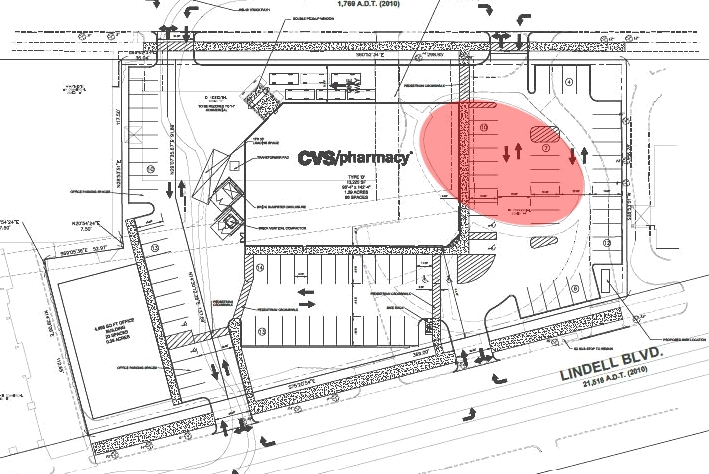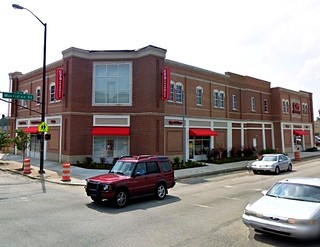 Just how does a community get a CVS or Walgreens store that doesn't suck? We're told that such chain pharmacies have a prototype building they like to build. Of course they do. That standardization makes them money, at least on the front end. But more communities are demanding something better than the anywhere 13,000 square foot box inside an asphalt donut. In St. Louis, CVS has tried to win approval to demolish the Lindell Avenue AAA building and build their prototype store. So far the community (Alderman, residents, city preservation board, mayor) has said "no" and CVS has said that they are determined to win. AAA also seeks demoltion as the CVS deal would result in a new building on the site for them. nextSTL has put forth design alternatives to incorporate a standard store on the site and a more urban vision, both retain the AAA building (additional nextSTL CVS/AAA coverage).
Just how does a community get a CVS or Walgreens store that doesn't suck? We're told that such chain pharmacies have a prototype building they like to build. Of course they do. That standardization makes them money, at least on the front end. But more communities are demanding something better than the anywhere 13,000 square foot box inside an asphalt donut. In St. Louis, CVS has tried to win approval to demolish the Lindell Avenue AAA building and build their prototype store. So far the community (Alderman, residents, city preservation board, mayor) has said "no" and CVS has said that they are determined to win. AAA also seeks demoltion as the CVS deal would result in a new building on the site for them. nextSTL has put forth design alternatives to incorporate a standard store on the site and a more urban vision, both retain the AAA building (additional nextSTL CVS/AAA coverage).
A quick glance around the Midwest finds numerous examples of better-than-box CVS and Walgreens stores. One striking example sits at Meridian and 16th Street in Indianapolis. How does a corner with an exisiting standard Walgreens, McDonald's and a Chase bank parking lot become home to a more urban CVS? I got in touch with Chris Barnett, the economic development coordinator for Near North Development Corp, the neigborhood CDC, when the project was built. Here's how Indianapolis got it's unlikely CVS:
CVS wanted to move from a less-prominent corner of two one-way streets three blocks from the corner of Meridian (a major north-south thoroghfare) and 16th Street. While many of that city's downtown streets are one-way, both streets here are two-way and see 30,000 and 20,000 cars a day, respectively.

{elevation of "East Coast", "historical" CVS model at 16th and Meridian}

{elevation of proposed CVS for AAA site on Lindell Boulevard}

{site plan of "East Coast", "historical" CVS model at 16th and Meridian}

{site plan of proposed CVS for AAA site on Lindell Boulevard (AAA building in pink)}
The corner on which CVS wished to relocate is covered by Indy's "Regional Center" overlay zoning ordinance, which had just gained design guidelines at the time of the project. Design approval was used as a lever. The project also required a variance for a drive-through pharmacy window. In St. Louis, the previous site sought by CVS on Lindell was abandoned after the neighborhood association utilized similar levers of power in an attempt to force CVS to build a more suitable building. The Post-Dispatch included this quote in its coverage, "Longtime residents said the dispute is heightened by the presence of recently arrived neighbors passionate about urban design."
Now, the AAA building and adjacent site is listed as a Specialty Mixed Use Area under the City of St. Louis Strategic Landuse Plan. By the city's definition, SMUAs are "Areas like downtown St. Louis where it is intended that a unique mix of uses be preserved and developed." In short, not a drive-through, single-use drugstore. As highlighted by Vanishing STL, the site is also within the boundaries of a pending form-based code. The new code will require buildings on this site to be at least three stories and 35 feet tall and be built very near the existing building line. Had it been in effect, and followed, the code would have precluded the demolition of the San Luis in 2009.

{3949 Lindell – adjacent to AAA site – shows the built form desired within the SMUA}

{a new form-based code will soon dictate more dense development at AAA site}
Prior to the proposal in Indianapolis, CVS had built a 2-story "historical" model store in Bloomington, IN. Regretably, that building shows that more than a building design is needed to create an urban form. So the model was there, and sitting less than an hour to the south. When pressed, CVS told Barnett that the "historical" model was an "East Coast" design for tighter urban spaces and historic neighbors. It has faux second story wndows and inside is a partial mezzanine for office & storage over the pharmacy.

{CVS in Bloomington, IN – an "East Coast" design lost in a sea of parking}
Apparently CVS doesn't consider the Lindell Avenue location in St. Louis to be a tight urban space, or that it has historic neighbors. The city has let the area be degraded with a suburban Walgreens and stand alone fast food – the worst being the Rally's adjacent to the AAA site. But project like 3949 Lindell, dense residential atop retail, highlights the potential for the area. In addition, the city has funding to survey its Mid-Century Modern architecture, of which there's a great concentration on Lindell, and a streetcar feasibility study will be begin soon for the Lindell corridor.
The CDC in Indy didn't get everything they wanted. CVS wouldn't agree to a corner entry, pointing out that it would be too far from handicapped parking. They also nixed dual entries, citing security concerns, and refused to use real windows on the upper level (pointing out that Walgreens didn't have them). The CDC proposed building the legal minimum parking for the site (~42 spaces). CVS insisted on 70+. The current CVS/AAA proposal in St. Louis shows 88 parking spaces.
Can CVS find a way to build a store and parking while retaining the AAA building?

{design showing traditional CVS store – image by Andrew Faulkner}

{design showing urban CVS store – image by Jeremy Clagett}
Since the CVS opened, the neighboring Walgreen's has opened up their windows and converted the store into their "neighborhood market" concept with an expanded grocery and fresh food selection. It's not yet known if CVS will attempt to respond in kind.
Like Lindell in St. Louis, Meridian has always been the marquee city street in Indy. It has everything from 1895 mansion to 1920's apartments to the Catholic Cathedral to MCM offices to 1970s Brutalist to 1980's Corporate to modern commercial. Architectural diversity is its strength, but also its weakness: when there's a bit of everything it's easy to point at something "worse". Sound familiar? Barnett remarked that the McDonald's across from CVS made their desire for an urban store more difficult.
The Indy CVS required demolition of an old-style IHOP that some suspected was making more on sales out the back door than their Strawberry Banana Danish Fruit Crepes, and an ugly windowless split-face-block 1st-generation big-box drugstore that closed and became a state probation office. The parking area was a used-car lot. This, according to Barnett meant that the CVS in any form would have met a neighborhood "better than what's there" test. Sadly, too often this is the only test applied.

{"better than what's there" is a high hurdle at the AAA site in St. Louis – photo by Toby Weiss}
The most recent public news in St. Louis is the city's Preservation Board unanimously voting to deny a preliminary review to demolish the AAA building. Then Monday afternoon, City of St. Louis Mayor Francis Slay Tweeted, "I'm told the next plans for a CVS on Lindell will preserve the round AAA building. #fgs." Reached for comment, 18th Ward Alderman Terry Kennedy state that he had not heard from CVS since prior to the Preservation Board meeting.
In St. Louis, the levers of power exist to demand a better CVS, perhaps something very similar to the result in Indianapolis. The leverage exists to retain the existing AAA building as well. The SMUA planning designation, presumably sought-after retail liquor license and drive-through pharmacy should all be used to produce not just a better result, but a good result. It's beginning to appear that St. Louis may do just that.
Finally, AAA isn't required to stay in its current building and judging by recent comments, likely won't (may we suggest some of the adjacent storefronts, or Lindell Marketplace?). The attorney representing AAA at the Preservation Board stated of the existing building, "It is a cookie cutter of another bank, of another bank, of another bank.", claiming that high utility costs and needed repairs means that no buyer would be interested. Previously, a spokesperson for AAA weighed in with "So somebody likes a round building. So what?"
So the building, if saved, will need a new occupant. Ultimately this is what will preserve any building. And there are tenants for unique buildings, as witnessed with the Midtown saucer (former Del Taco) several blocks east. The AAA building hasn't been marketed, but the recent publicity may stir up interest. What business type would be a good fit? What would you like to see there? Who will step up?


